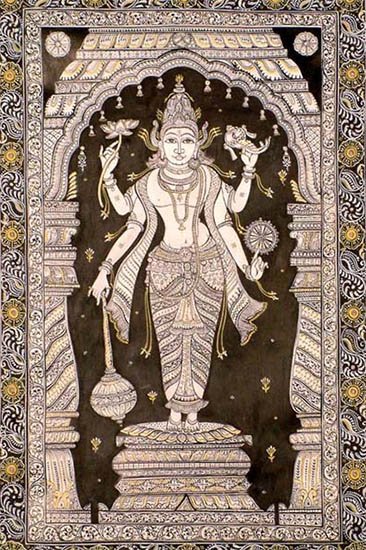Abhitapta, Abhitaptā: 10 definitions
Introduction:
Abhitapta means something in Hinduism, Sanskrit. If you want to know the exact meaning, history, etymology or English translation of this term then check out the descriptions on this page. Add your comment or reference to a book if you want to contribute to this summary article.
In Hinduism
Shilpashastra (iconography)
Source: Google Books: The Book of Hindu Imagery: Gods, Manifestations and Their MeaningA type of glance (or facial expression): Abhitapta (burnt): the eyelids moving, the pupils gazing languidly. Usage: indifference (i.e. regarding a thing, but without interest)

Shilpashastra (शिल्पशास्त्र, śilpaśāstra) represents the ancient Indian science (shastra) of creative arts (shilpa) such as sculpture, iconography and painting. Closely related to Vastushastra (architecture), they often share the same literature.
Natyashastra (theatrics and dramaturgy)
Source: Wisdom Library: Nāṭya-śāstraAbhitaptā (अभितप्ता, “distressed”) refers to a specific “glance” (dṛṣṭi), according to the Nāṭyaśāstra chapter 8. This is a type of glance that expresses a ‘transitory state’ (saṃcāribhāva). There are a total thirty-six glances defined.
Source: archive.org: Natya ShastraAbhitaptā (अभितप्ता).—A type of glance (dṛṣṭi) expressing a transitory state (saṃcāribhāva);—The Glance in which the eyeballs are slowly moving due to the movement of the eyelids, and which indicates much distress and pain, is called Abhitaptā (distressed).
Uses of Abhitaptā (distressed)—in discouragement, accidental hurt and distress.
Source: Shodhganga: Elements of Art and Architecture in the Trtiyakhanda of the Visnudharmottarapurana (natya)Abhitaptā (अभितप्ता) refers to one of the Thirty six kinds of Glances (dṛṣṭi) or “proper accomplishment of glances” (in Indian Dramas), according to the Viṣṇudharmottarapurāṇa, an ancient Sanskrit text which (being encyclopedic in nature) deals with a variety of cultural topics such as arts, architecture, music, grammar and astronomy.—Dṛṣṭi is very important in a dance form. The appropriate movements of eyes, eyeballs and eyebrows of an artist make the performance more charming. There are thirty six kinds of glances (dṛṣṭi) accepted in the Viṣṇudharmottarapurāṇa, for example abhitaptā, belonging to the sañcāriṇadṛṣṭi division.

Natyashastra (नाट्यशास्त्र, nāṭyaśāstra) refers to both the ancient Indian tradition (shastra) of performing arts, (natya—theatrics, drama, dance, music), as well as the name of a Sanskrit work dealing with these subjects. It also teaches the rules for composing Dramatic plays (nataka), construction and performance of Theater, and Poetic works (kavya).
Languages of India and abroad
Sanskrit dictionary
Source: DDSA: The practical Sanskrit-English dictionaryAbhitapta (अभितप्त).—p. p.
1) Heated, inflamed, scorched, burnt.
2) Distressed, grieving or lamenting for (actively used).
Source: Cologne Digital Sanskrit Dictionaries: Shabda-Sagara Sanskrit-English DictionaryAbhitapta (अभितप्त).—mfn.
(-ptaḥ-ptā-ptaṃ) 1. Scorched, burnt. 2. Afflicted. E. abhi, and tapta burnt.
Source: Cologne Digital Sanskrit Dictionaries: Monier-Williams Sanskrit-English Dictionary1) Abhitapta (अभितप्त):—[=abhi-tapta] [from abhi-tap] mfn. scorched, burnt
2) [v.s. ...] afflicted about ([accusative]), [Rāmāyaṇa]
Source: Cologne Digital Sanskrit Dictionaries: Goldstücker Sanskrit-English DictionaryAbhitapta (अभितप्त):—[tatpurusha compound] m. f. n.
(-ptaḥ-ptā-ptam) 1) Scorched, burnt.
2) Afflicted. E. tap with abhi, kṛt aff. kta.
Source: Cologne Digital Sanskrit Dictionaries: Yates Sanskrit-English DictionaryAbhitapta (अभितप्त):—[abhi-tapta] (ptaḥ-ptā-ptaṃ) a. Burnt.
Source: DDSA: Paia-sadda-mahannavo; a comprehensive Prakrit Hindi dictionary (S)Abhitapta (अभितप्त) in the Sanskrit language is related to the Prakrit words: Abhitatta, Ahitatta.
Sanskrit, also spelled संस्कृतम् (saṃskṛtam), is an ancient language of India commonly seen as the grandmother of the Indo-European language family (even English!). Closely allied with Prakrit and Pali, Sanskrit is more exhaustive in both grammar and terms and has the most extensive collection of literature in the world, greatly surpassing its sister-languages Greek and Latin.
See also (Relevant definitions)
Ends with: Prathamabhitapta.
Relevant text
Search found 3 books and stories containing Abhitapta, Abhitaptā, Abhi-tapta; (plurals include: Abhitaptas, Abhitaptās, taptas). You can also click to the full overview containing English textual excerpts. Below are direct links for the most relevant articles:
Abhinaya-darpana (English) (by Ananda Coomaraswamy)
Vishnudharmottara Purana (Art and Architecture) (by Bhagyashree Sarma)
2.6. Dṛṣṭi (sight or glance) < [Chapter 3 - Drama and Dance]
Natyashastra (English) (by Bharata-muni)